The vast expanse of the night sky has captivated humanity for millennia, offering a window into cosmic wonders. Whether you’re a complete novice or a seasoned observer, having the right tool is key to unlocking these celestial sights. A quality stargazing telescope can transform distant points of light into detailed worlds and nebulous clouds. This guide cuts through the technical jargon to help you discover the perfect stargazing telescope that fits your needs, budget, and skill level. Prepare to embark on a journey of discovery right from your backyard, revealing the breathtaking beauty hidden above. Choosing a good backyard telescope is the first step into amateur astronomy.
May 2025 promises celestial delights, including the radiant Flower Moon on the 12th. While beautiful to the naked eye, a stargazing telescope enhances this spectacle. As the moonlight fades, the opportunity arises to appreciate the diverse colors of stars – from the blue-white brilliance of the Summer Triangle to the warm hues of orange Arcturus and reddish Antares. Enthusiasts eager to observe the ringed beauty of Saturn or its pre-dawn dance with the crescent moon on May 22 will find a quality stargazing telescope indispensable.
Buying your first stargazing telescope can feel daunting, but our comprehensive guide simplifies the process. We provide expert, hands-on reviews covering a spectrum of budgets, skill levels, and observing purposes. Our aim is to ensure you select a stargazing telescope that delivers on its promises, offering ease-of-use and remarkable observational capabilities.
Top Stargazing Telescope Recommendations for 2025
Choosing an amateur astronomy telescope can be confusing, but this curated list highlights some of the best options available for unlocking the wonders of the night sky.
| Telescope Model | Best For… |
|---|---|
| Celestron NexStar 4SE | Beginners looking for GoTo technology |
| Celestron Inspire 100AZ Refractor | Budget-conscious beginners |
| Celestron Astro Fi 130 | Value for enthusiasts/Beginner-friendly GoTo |
| Celestron NexStar Evolution 9.25 | Premium GoTo performance |
| Celestron Origin Intelligent Home Observatory | Astrophotography & Automated Viewing |
| Celestron NexStar 8SE | Motorized, versatile observing & imaging |
| Celestron Astro Fi 102 | Portability & Easy GoTo |
| Sky-Watcher Skymax 150 PRO | Astrophotography accessories |
| Unistellar eQuinox 2 telescope | Smart features & Urban observing |
| Celestron Advanced VX 8 EdgeHD | Deep space, veteran astronomers |
| Celestron FirstScope 76 Tabletop | Kids & Casual viewing |
Detailed Stargazing Telescope Reviews
Our expert team provides in-depth insights into each recommended stargazing telescope, evaluating their performance, features, and suitability for different users.
Celestron NexStar 4SE Stargazing Telescope
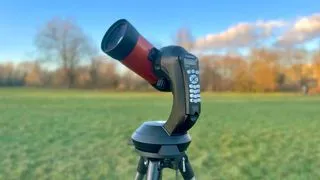 Man setting up Celestron NexStar 4SE stargazing telescope in a field at sunset
Man setting up Celestron NexStar 4SE stargazing telescope in a field at sunset
Ideal for newcomers, the Celestron NexStar 4SE is a user-friendly GoTo stargazing telescope praised for its quick setup and clear images. Celestron’s SkyAlign technology simplifies locating celestial objects, making the initial steps into astronomy effortless.
Specifications
- Optical design: Maksutov-Cassegrain
- Mount type: Computerized Alt-Azimuth
- Aperture: 4-inches / 102mm
- Focal length: 1325mm
- Highest useful magnification: 241x
- Lowest useful magnification: 15x
- Supplied eyepieces: 25mm
- Weight: 23 lbs (10.44kg) fully assembled
Reasons to Buy
- Uncomplicated, quick setup
- Automatically finds night sky objects (GoTo)
- High quality, sturdy build
- No collimation required
Reasons to Avoid
- Narrow field of view
- Not highly portable
- Limited supplied accessories
In our full review, this stargazing telescope proved excellent for viewing planets and bright objects. Its 4-inch aperture and 1325mm focal length provide sharp views. However, the narrow 1.2-degree field of view means larger deep-sky objects are challenging to fit into the frame. While it comes with a 25mm Plossl eyepiece, adding a 32mm eyepiece and a Barlow lens can significantly enhance its capabilities up to 241x magnification. This stargazing telescope is robust but heavy (23 lbs) and its tripod doesn’t fold completely, limiting portability. It also consumes batteries quickly, making an external power source highly recommended, especially for backyard stargazing where power is accessible. The solid design and automated features make the NexStar 4SE a strong contender as a good backyard telescope for beginners prioritizing ease of use.
Celestron Inspire 100AZ Stargazing Telescope
 Close-up of the focusing knob on a Celestron Inspire 100AZ stargazing telescope
Close-up of the focusing knob on a Celestron Inspire 100AZ stargazing telescope
An excellent budget-friendly option, the Celestron Inspire 100AZ Refractor is designed for budding skywatchers seeking a straightforward and affordable stargazing telescope. It’s easy to set up and comes with several useful accessories.
Specifications
- Optical design: Refractor
- Mount type: Alt-azimuth
- Aperture: 3.94-inches / 100mm
- Focal length: 660mm
- Highest useful magnification: 241x
- Lowest useful magnification: 15x
- Supplied eyepieces: 10mm, 25mm
- Weight: 20 lbs (9.07kg)
Reasons to Buy
- Sharp views of planets and the moon
- Handy smartphone adaptor for astrophotography
- Built-in red light
- Lightweight frame
Reasons to Avoid
- Bearings lack precision
- Some chromatic aberration (false color)
- Not suitable for solar observing
This achromatic refractor, with a 100mm aperture and 660mm focal length, is ideal for viewing planets and the moon from home. Mounted on a simple alt-azimuth mount, it offers easy side-to-side and up-and-down movement. The 100mm aperture gathers sufficient light for views of brighter nebulas and galaxies, while the focal length provides good magnification for planetary detail. Our review noted some minor false color fringing and slight blurring at the field edges, which can be improved by investing in better eyepieces. A unique feature is the lens cap that converts into a smartphone adapter for capturing astro shots. This makes it a great entry-level hobby telescope for those wanting to dabble in smartphone astrophotography.
Celestron Astro Fi 130 Stargazing Telescope
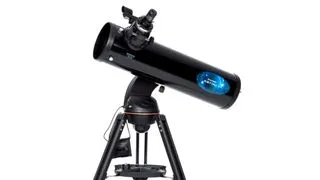 Celestron Astro Fi 130 stargazing telescope on a tripod on a white background
Celestron Astro Fi 130 stargazing telescope on a tripod on a white background
Offering excellent value for enthusiasts, the Celestron Astro Fi 130 is a highly capable entry-level stargazing telescope featuring smart technology at an accessible price. It’s portable and user-friendly, making it great for spontaneous observations.
Specifications
- Optical design: Newtonian Reflector
- Mount type: Computerized altitude-azimuth single fork
- Aperture: 5.19-inches / 130mm
- Focal length: 650mm
- Highest useful magnification: 307x
- Lowest useful magnification: 19x
- Supplied eyepieces: 25mm and 10mm
- Weight: 18 lbs (8.6kg)
Reasons to Buy
- Suitable for low budgets
- Great entry-level telescope
- Vixen dovetail for mount changes
- Portable
- Computer recommends targets
- Finds targets at the touch of a button
Reasons to Avoid
- Supplied eyepieces limit observations
- Focuser quality could be better
- Battery drains quickly
- Requires app functionality
This well-constructed Newtonian reflector on a sturdy aluminum tripod provides good views for its price. The included 10mm and 25mm Kellner eyepieces offer magnifications of 65x and 26x, respectively. Upgrading to better Plossl eyepieces is recommended for optimal performance. It’s very beginner-friendly thanks to SkyAlign technology and the Celestron SkyPortal app, which allows control via smartphone or tablet and can suggest objects to view. Views of the moon, Venus, Mars, and even the Andromeda Galaxy are achievable. While its batteries drain quickly in cold weather, making a 12V rechargeable pack a wise investment, its overall features and portability make it an attractive option for a beginner or an amateur astronomy telescope.
Celestron NexStar Evolution 9.25 Stargazing Telescope
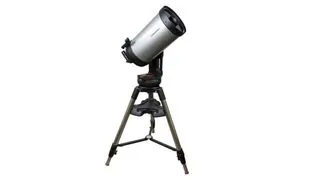 Celestron NexStar Evolution 9.25 stargazing telescope on a tripod on a white background
Celestron NexStar Evolution 9.25 stargazing telescope on a tripod on a white background
A premium GoTo stargazing telescope, the Celestron NexStar Evolution 9.25 delivers breathtaking, high-definition views of the universe. While it comes at a premium price, its performance and ease of use justify the cost, particularly for more experienced observers.
Specifications
- Optical design: Schmidt-Cassegrain
- Mount type: Computerized alt-azimuth fork arm
- Aperture: 9.25-inches / 235mm
- Focal length: 2350mm
- Highest useful magnification: 555x
- Lowest useful magnification: 34x
- Supplied eyepieces: 13mm, 40mm
- Weight: 62.60 lbs (28.39kg)
Reasons to Buy
- Crisp views with no optical defects
- Easy to set up despite advanced features
- High-quality, sturdy design
- Long battery life (10 hours)
Reasons to Avoid
- Isn’t very portable — best for backyard stargazing
- Expensive
This outstanding GoTo scope features a large 235mm aperture and a stable single-fork arm mount. The motorized mount includes a rechargeable lithium-ion battery offering up to 10 hours of continuous use, perfect for extended observing sessions. It includes useful accessories like a red dot finderscope, star diagonal, and two eyepieces (13mm and 40mm). While easy enough for beginners, its advanced features and capabilities are best appreciated by passionate astronomers. Astrophotographers will benefit from the motorized mount’s ability to track celestial objects. Control via the free Celestron SkyPortal app is seamless. Its significant weight makes it less portable, but for a stationary backyard amateur astronomy telescope offering superior views, it’s a top choice.
Celestron Origin Intelligent Home Observatory Stargazing Telescope
 Black and white Celestron Origin stargazing telescope in a field, designed for astrophotography
Black and white Celestron Origin stargazing telescope in a field, designed for astrophotography
The Celestron Origin Intelligent Home Observatory redefines the stargazing telescope experience with its smart, automated capabilities, particularly excelling in astrophotography. This unique scope replaces the traditional eyepiece with a built-in camera, allowing views and imaging on a mobile device.
Specifications
- Optical design: Rowe-Ackermann Schmidt Astrograph (RASA)
- Mount type: Motorized Alt-azimuth
- Aperture: 6-inches / 152mm
- Focal length: 335mm
- Highest useful magnification: N/A (Digital)
- Lowest useful magnification: N/A (Digital)
- Supplied eyepieces: N/A
- Weight: 41.6 lbs (18.6 kg)
Reasons to Buy
- Crystal clear deep sky photos in seconds
- Quick setup
- Easy-to-use, helpful app
- Automatically stacks and processes images
Reasons to Avoid
- Not ideal for all celestial objects (e.g., planets)
- Quite large and heavy
- No traditional eyepiece
This smart stargazing telescope takes automation to the next level. Its 6.2MP sensor captures multiple images rapidly, stacking them in real-time to produce stunning, low-noise images of deep-sky objects, even under light pollution. The accompanying app makes operation effortless, allowing users to select objects and have the telescope slew to them automatically. While excellent for nebulas and galaxies, our review found imaging planets more challenging. Beginners with no prior astronomy experience will appreciate the automated focusing, tracking, and image processing. However, its lack of an eyepiece and a price tag around $4,000 make it a specialized, high-end option, perhaps more suited as a dedicated astrophotography or automated hobby telescope.
Celestron NexStar 8SE Stargazing Telescope
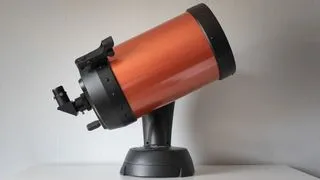 Celestron NexStar 8SE stargazing telescope showing uncluttered sides and focus knob
Celestron NexStar 8SE stargazing telescope showing uncluttered sides and focus knob
Dubbed “The World’s Most Beloved Telescope,” the Celestron NexStar 8SE is a highly flexible and powerful motorized stargazing telescope suitable for all skill levels. Its impressive optics deliver bright, detailed views for deep space exploration and astrophotography.
Specifications
- Optical design: Schmidt-Cassegrain
- Mount type: Computerized alt-azimuth fork arm
- Aperture: 8-inches / 203mm
- Focal length: 2032mm
- Highest useful magnification: 480x
- Lowest useful magnification: 29x
- Supplied eyepieces: 25mm
- Weight: 32 lbs (14.48kg)
Reasons to Buy
- Incredibly bright and sharp views
- Sharpness across the entire field of view
- Excellent value for money considering performance
- Great for astrophotography
Reasons to Avoid
- Price may deter some beginners
- Slight lag with remote control slewing
This stargazing telescope is an investment built to last, ideal for learning and growing with in the hobby. Its 8-inch aperture and Schmidt-Cassegrain design gather significant light for breathtaking views of the solar system and beyond. The motorized fork arm mount is smooth and accurate, making it suitable for long-exposure astrophotography. The SkyAlign app and handheld remote control simplify finding objects, offering categories like ‘solar system’, ‘stars’, ‘deep sky’, or an automated ‘sky tour’. Its catadioptric design keeps the tube relatively short for portability, though it still weighs 32 lbs. Note that it requires 8x AA batteries, so rechargeable batteries are a must. This amateur astronomy telescope is highly recommended for serious enthusiasts due to its optical quality and versatility.
Celestron Astro Fi 102 Stargazing Telescope
 Celestron Astro Fi 102 stargazing telescope with battery pack
Celestron Astro Fi 102 stargazing telescope with battery pack
For stargazers on the move, the Celestron Astro Fi 102 is the best lightweight and portable GoTo stargazing telescope. Its compact size and easy setup make it perfect for beginners who want to escape urban light pollution.
Specifications
- Optical design: Maksutov-Cassegrain
- Mount type: Computerized Alt-Azimuth Single Fork Arm
- Aperture: 4.0-inches / 102mm
- Focal length: 1325mm
- Highest useful magnification: Up to 100x with digital zoom
- Lowest useful magnification: 15x
- Supplied eyepieces: 25mm and 10mm
- Weight: 6 lbs (2.7kg)
Reasons to Buy
- Very portable thanks to lightweight design
- Reasonably and fairly priced
- No prior experience needed with GoTo
Reasons to Avoid
- Optics could be better
- Tripod isn’t the best quality
- Doesn’t feel like a premium product
This Maksutov-Cassegrain stargazing telescope is a boon for portability, weighing only 6 lbs. Integrated WiFi and the Celestron SkyPortal app provide access to a database of 100,000 celestial objects for automated tracking. While initial setup can be tricky, the GoTo functionality simplifies finding targets. Views of the moon, Mars, Saturn, and Jupiter are good for the price, though sharpness drops towards the edges. The included tripod feels a bit flimsy and may need weighing down. Its plastic casing is not fully sealed, so protection from moisture is advised. Despite some compromises in build quality, its ease of use and extreme portability make it an excellent choice for a grab-and-go hobby telescope.
Sky-Watcher Skymax 150 PRO Stargazing Telescope
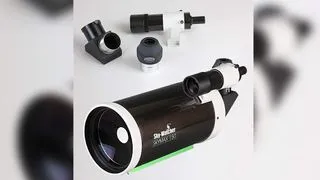 Sky-Watcher Skymax 150 PRO stargazing telescope with accessories
Sky-Watcher Skymax 150 PRO stargazing telescope with accessories
Ideal for astrophotographers who want to accessorize, the Sky-Watcher Skymax 150 PRO is a versatile Maksutov-Cassegrain stargazing telescope. It offers outstanding optical quality and is compatible with various cameras and add-ons.
Specifications
- Optical design: Maksutov-Cassegrain
- Mount type: Equatorial (EQ-5 Pro – Note: Mount may not always be included, check listing)
- Aperture: 5.90-inches / 150mm
- Focal length: 1800mm
- Highest useful magnification: 450x
- Lowest useful magnification: 36x
- Supplied eyepieces: 28 mm
- Weight: 13.23 lbs (6kg)
Reasons to Buy
- High-quality, lightweight build (OTA only)
- Excellent optics with minimal distortion
- Great for a wide selection of astrophotography targets
- Smooth focuser
Reasons to Avoid
- Not all models come with a tripod/mount
- Comes with only one eyepiece
Weighing only 13.23 lbs (for the optical tube assembly), this stargazing telescope is portable for transport to dark sky sites. Its Maksutov-Cassegrain design delivers crisp, distortion-free views across a wide range of celestial objects, from planets to nebulas and galaxies. The 1800mm focal length provides substantial magnification, while the 150mm aperture gathers ample light. The telescope features a smooth focuser, crucial for astrophotography, and a Vixen-style dovetail plate for easy mounting. Its compatibility with accessories like CCD or DSLR cameras and filter wheels makes it an excellent dedicated amateur astronomy telescope for imaging. While you might need to purchase a mount and additional eyepieces separately, its optical performance and flexibility offer great value.
Unistellar eQuinox 2 Smart Stargazing Telescope
 Unistellar eQuinox 2 smart stargazing telescope in use against a starry sky
Unistellar eQuinox 2 smart stargazing telescope in use against a starry sky
A modern, high-tech stargazing telescope, the Unistellar eQuinox 2 utilizes smart features and a mobile app for simplified astronomy. It’s particularly effective in urban environments thanks to its light pollution reduction technology.
Specifications
- Optical design: Newtonian Reflector
- Mount type: Motorized GoTo alt-azimuth
- Aperture: 4.49-inches / 114mm
- Focal length: 450mm
- Highest useful magnification: 400x digital
- Lowest useful magnification: 50x optical
- Supplied eyepieces: N/A
- Weight: 19.8 lbs (9kg)
Reasons to Buy
- Beautiful, simple layout and design
- Quick access to night sky objects via app
- App is easy to operate
- Smart Light Pollution Reduction feature
Reasons to Avoid
- Image resolution is average for the price
- Can’t orientate telescope in twilight
- Laggy views when focusing (on app)
- Expensive
This smart stargazing telescope integrates a 6.2MP image sensor and the Unistellar app for automated viewing and imaging on a mobile device. It captures and stacks images in real-time, making objects brighter and more detailed, a significant advantage in light-polluted areas. Setup is quick using the Autonomous Field Detection feature, and the intuitive app allows easy navigation through a large database of celestial objects. While convenient and excellent for casual viewing and sharing images, the digital zoom and image stacking result in only average resolution compared to traditional methods. It’s a premium device (around $2,000) best suited for those prioritizing ease of use, automated features, and urban observing capabilities over traditional viewing or high-resolution imaging. It represents a modern take on the hobby telescope for the tech-savvy.
Celestron Advanced VX 8 EdgeHD Stargazing Telescope
 Celestron Advanced VX8 Edge HD stargazing telescope with computerized mount
Celestron Advanced VX8 Edge HD stargazing telescope with computerized mount
Designed for serious amateur astronomers, the Celestron Advanced VX 8 EdgeHD is an optically superior stargazing telescope perfect for deep space observation and astrophotography. Its EdgeHD technology provides pinpoint sharpness across the entire field of view.
Specifications
- Optical design: Schmidt-Cassegrain (EdgeHD)
- Mount type: Motorized equatorial (Advanced VX mount)
- Aperture: 8-inches / 203.2mm
- Focal length: 2032mm
- Highest useful magnification: 480x
- Lowest useful magnification: 29x
- Supplied eyepieces: 40mm
- Weight: 61 lbs (27.67kg)
Reasons to Buy
- EdgeHD optics provide best-in-class views
- Computerized equatorial mount finds and tracks objects reliably
- Dovetail mount system for accessories
- Proven, refined design
Reasons to Avoid
- Setting up requires some knowledge of the sky
- Only one eyepiece supplied
- Needs a sturdier mount for serious long-exposure astrophotography
This high-end stargazing telescope utilizes Celestron’s EdgeHD technology to correct field curvature, ensuring sharp stars from the center to the edge of the image, critical for astrophotography. The 8-inch aperture and 2032mm focal length deliver dramatic views of planets, globular clusters, and galaxies down to 12th magnitude. The included Advanced VX equatorial mount is motorized, capable of tracking objects across the meridian without a flip, and supports up to 30 lbs of payload. While setup requires some astronomical knowledge (compared to simpler Alt-Az GoTo mounts), the computerized tracking is smooth and reliable. Supplied with a 40mm eyepiece, additional eyepieces are needed for varied magnification. This robust instrument is designed for longevity and is an excellent amateur astronomy telescope that serious hobbyists won’t quickly outgrow.
Celestron FirstScope 76 Tabletop Stargazing Telescope
 Celestron FirstScope 76 Tabletop stargazing telescope, ideal for kids
Celestron FirstScope 76 Tabletop stargazing telescope, ideal for kids
An affordable and easy-to-use stargazing telescope perfect for introducing children or casual observers to the wonders of the night sky. The Celestron FirstScope 76 is a compact tabletop Dobsonian reflector.
Specifications
- Optical design: Reflector (Dobsonian)
- Mount type: Dobsonian (Tabletop alt-azimuth)
- Aperture: 2.99-inch / 76mm
- Focal length: 11.81-inch / 300mm
- Highest useful magnification: 180x
- Lowest useful magnification: 11x
- Supplied eyepieces: 4mm, 20mm
- Weight: 4.5 lbs / 2.04kg
Reasons to Buy
- Very portable and lightweight
- Extremely easy to use (comes pre-assembled)
- Robust build for the price
- Low investment for casual or young astronomers
- Fast focal ratio (f/3.95) for wide-angle views
Reasons to Avoid
- Loose focuser
- Some observations lack clarity and detail at high magnifications
- Challenging to collimate (align mirrors)
- Finderscope not supplied
This stargazing telescope is designed for simplicity and immediate use – it arrives fully assembled. Its 76mm aperture and fast f/3.95 focal ratio make it capable of showing brighter deep-sky objects in addition to the moon and planets, although views are best at lower magnifications. The tabletop design requires a stable surface for observing. Weighing just 4.5 lbs, it’s highly portable, but its robust, non-glossy plastic build feels surprisingly sturdy. A major drawback is the absence of a finderscope, which is essential for easily locating targets; purchasing a simple red dot finder separately is highly recommended. Despite some optical limitations and the missing finderscope, its low cost, ease of use, and portability make it an excellent first hobby telescope for sparking interest in astronomy.
Stargazing Telescope FAQ
Dr. Gemma Lavender, a contributing expert with extensive astronomical knowledge, answers some common questions about choosing and using a stargazing telescope.
How do I choose the right stargazing telescope for me?
Selecting the perfect stargazing telescope involves navigating technical terms and a wide range of options. Fortunately, modern telescopes offer good quality even at entry levels. The primary factor is optical quality, determined by aperture and focal length, which dictates how much light is gathered and the potential magnification. Consider your observing location (backyard vs. dark sky site – impacting the need for portability), the objects you wish to view (planets vs. deep sky), and whether you plan on trying astrophotography. Beginner telescopes or simple Newtonian reflectors on Dobsonian mounts often offer the best value aperture for your money. For ease of use and portability, especially if you like gadgets, a smaller refractor or a catadioptric stargazing telescope with a computerized mount might be ideal. Always buy from reputable dealers for quality assurance and warranty.
What types of stargazing telescope are there?
There are three main types of stargazing telescope:
- Reflector Telescopes: Use mirrors (primary and sometimes secondary) to gather and focus light. Newtonian reflectors, including Dobsonian mounts, are common and offer great aperture for their price. They are excellent for low-magnification views of galaxies and nebulas. They require occasional mirror alignment (collimation).
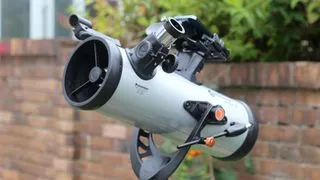 Celestron StarSense Explorer LT 114AZ reflector stargazing telescope
Celestron StarSense Explorer LT 114AZ reflector stargazing telescope - Refractor Telescopes: Use lenses to bend (refract) light to form an image. They are often simple to set up and require low maintenance, making them popular beginner instruments. They are best suited for viewing the moon and planets due to high contrast, but larger apertures become very expensive. Achromatic refractors can suffer from chromatic aberration (false color), which is corrected in more expensive apochromatic (APO) refractors using special glass.
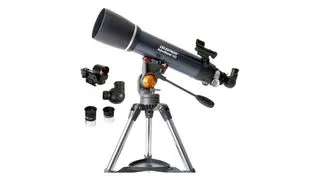 Celestron AstroMaster 102AZ refractor stargazing telescope
Celestron AstroMaster 102AZ refractor stargazing telescope - Catadioptric Telescopes: Combine both mirrors and lenses (Schmidt-Cassegrain and Maksutov-Cassegrain are common sub-types). They offer compact, portable designs with high magnification potential, making them versatile for both planetary and deep-sky viewing. They are often more expensive but require minimal maintenance due to sealed tubes. They are popular as a versatile amateur astronomy telescope.
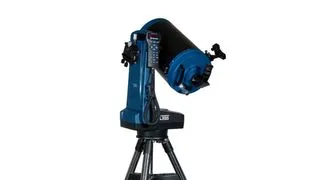 Meade Instruments LX65 GoTo catadioptric stargazing telescope
Meade Instruments LX65 GoTo catadioptric stargazing telescope
Computerized (GoTo or Push-to) mounts are available for all types, automating object location but increasing cost.
What is a finderscope on a stargazing telescope?
A finderscope is a small, low-magnification telescope or sight mounted on your main stargazing telescope. Because the main telescope has a high magnification and narrow field of view, it’s difficult to initially point it at a specific object. The finderscope, with its wide field of view and often crosshairs or a red dot, acts like a magnified gun sight. You first locate your desired target in the finderscope’s wider view, center it, and then when you look through the main telescope’s eyepiece, the object will be in the field of view. Finderscopes can have straight-through or right-angled views, and some produce an inverted or reversed image, which can be disorienting for beginners.
 Celestron StarSense Explorer 8-inch Dobsonian red dot finderscope
Celestron StarSense Explorer 8-inch Dobsonian red dot finderscope
What does aperture, magnification and focal length mean on a stargazing telescope?
These are key terms when understanding a stargazing telescope:
- Aperture: The diameter of the main lens (refractor) or primary mirror (reflector/catadioptric). It is the most critical specification as it determines the light-gathering ability and resolution (ability to see fine detail). A larger aperture collects more light, allowing you to see fainter objects and resolve finer details.
- Focal Length: The distance from the main lens or mirror to the point where light is focused to form an image. It affects the magnification achievable with a given eyepiece and the field of view. A longer focal length results in higher magnification and a narrower field of view with the same eyepiece.
- Magnification: How much larger an object appears when viewed through the telescope. It is calculated by dividing the telescope’s focal length by the focal length of the eyepiece used. While high magnification sounds appealing, excessive magnification spreads the collected light over a larger area, making the image dimmer and more susceptible to atmospheric turbulence (“seeing” conditions). There’s a practical limit to useful magnification, usually considered to be about twice the telescope’s aperture in millimeters.
Magnification: How do stargazing telescope eyepieces work?
 Celestron StarSense Explorer 8-inch Dobsonian close up view of eyepiece
Celestron StarSense Explorer 8-inch Dobsonian close up view of eyepiece
Eyepieces are interchangeable lenses that you look through at the end of a stargazing telescope. They magnify the image formed by the telescope’s objective lens or primary mirror. Each eyepiece has a specific focal length (in millimeters). A shorter eyepiece focal length provides higher magnification. For example, a 1000mm focal length telescope used with a 10mm eyepiece yields 100x magnification (1000 / 10 = 100). It’s recommended to have a set of eyepieces offering low, medium, and high magnifications (e.g., providing ~50x, 100x, and 200x with your telescope) to suit different objects and seeing conditions. The exit pupil (telescope aperture divided by magnification) should ideally match or be smaller than your dark-adapted eye’s pupil (around 7mm) to ensure all collected light reaches your eye.
How We Test the Best Stargazing Telescopes
To provide reliable recommendations for the best stargazing telescope, each model undergoes thorough, hands-on testing. Our expert reviewers spend hours using each telescope for observation, assessing its performance across various criteria.
We evaluate the build quality of the Optical Tube Assembly (OTA), noting the type of telescope (refractor, reflector, catadioptric), its components, size, and lens clarity. We also consider maintenance needs, such as collimation (mirror alignment) for reflector telescopes and cleaning.
Accessories like eyepieces and mounts are assessed for functionality and quality. Motorized alt-azimuth and equatorial mounts are tested for smooth movement and tracking accuracy. The star alignment process, whether manual or automated (like GoTo systems), is also a key testing point.
Recognizing that telescopes can be complex, we consider the required astronomical knowledge for easy operation. We also evaluate portability, assessing how easy a stargazing telescope is to transport to darker observing sites away from light pollution.
The most crucial part of our testing is evaluating observational performance. We describe our viewing experiences with various celestial objects, including the moon, planets (like Jupiter and Saturn), and deep-sky objects (Messier objects, nebulas, galaxies), noting image brightness, sharpness, and the presence of aberrations or distortions.
Our reviews compare manufacturer claims against real-world performance. Our testing team consists of seasoned stargazers and freelance reviewers with years of experience, supported by consultations with astronomy experts to ensure the accuracy and relevance of our information on telescope use.
Update Log
Recent updates
*Editor’s note 05/08/2025***:** Updated introduction to include details of the May 12 full moon, colorful stars in the night sky (Summer Triangle, Arcturus, Antares) and Saturn’s appearance.
Choosing the right stargazing telescope is your ticket to exploring the universe. With options ranging from simple backyard models to advanced instruments for astrophotography, there’s a perfect fit for every aspiring astronomer. Consider what you want to see, where you’ll observe, and your budget, and use this guide to make an informed decision. The night sky awaits!
